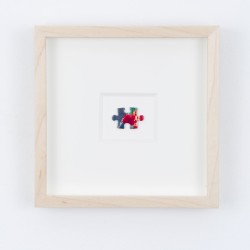WP: You know, I´m dying to go to Japan for a season to study traditional gardening, because I´ve always like the idea of making a series of intelligent cuts in something natural, a growing plant, that change the way it grows and aid its natural development- in other words, an artificial movement that makes its natural development much more comfortable, and the plant more magnificent. This seems to me to be a very good explanation of a situation where you are using reality, where you are communicating something in reality through art, where you are modifying something that in turns allows for a much more effective communication, a simple click, a simple movement.
RF: … and let’s not forget that we both have a great sense of humor. Deep down I think I am a genius without talent, and if I explain what I mean by genius, you will understand my point of view. I just think men and women are geniuses, but most people forget it (they are too busy exploiting their talents).
WP: Nowadays, those artists that sell are deemed successful. This is totally unfair but it’s accepted as normal.
RF: I had walked on city streets, and in shops, galleries and museums, to sell tiny works of art (if I remember correctly they sold for 5 francs each, or they could be exchanged for a drink).
WP: Now you don´t give back what you´ve been lent, you keep sharing it; you share images, archives, I stay at your house without even knowing you, and somebody stays at mine in Havana, and even leaves a note and waters the plants. There´s a different idea of sharing, of how we understand what belongs to whom. And we can look at this in relation to the artwork. I´m interested in this idea of what belongs to me and what doesn´t belong to me, of turning into a kid of selector in a cloud up there where the ideas live, where all the concerns of the world live, and where my place as an artist is only to indicate and focalize. But anybody can have that power.
RF: Do you know this quote by Shakespeare: “There is nothing good or bad; it is human thought that makes it so.” I say it this way: there is nothing good or bad, it is only the combination that makes it so.
WP: Right, right… The problem is the design of how we understand art, the design of what the market does, the design of what the institution or educations does, blah blah blah… But in truth, when you´re communicating, when you´re clearly reflecting your reality, your reality is objects: you´re full of objects, of actions that are happening, movements, meanings that are all around you. So that, for me, is the material for my work.
RF: For me, in general, it is the material that gives me the idea and not the idea that gives me the material. Most of the time I start with what surrounds me, and it is by using it that perhaps a concept emerges. In the case of bricks … what I like about bricks is the ocher color, especially I like refractory, I like bricks, and the contrast between the weight of the brick and the lightness of the spirit, is something that interests me . It started from there.
WP: It is about getting into the structure of language today, and all the possibilities of interpretation that art opens up, where art becomes a laboratory of possibilities. The metaphor closes to the maximum to open up to its greatest potential.
RF: A few years back in the late 50s and 60s when I was asked what I was doing – kinda nobody interested in what we were doing at the time- I used to say “Oh, I’m not in a hurry, I’m working for maybe in the year 2000 some of these ideas, concepts we’re working now would be useful.” But up late I come to say “I consider myself as working for the year 3000.”
WP: It looks like we are in the same place, but imagine looking at this in, say, a hundred years, where we´ll see how great the differences between artists were.
I really like the idea of the void. Not only the physical void but the void as a temporal parenthesis in which you connect with history.
The tree grows upwards and downwards.
NoguerasBlanchard
_






